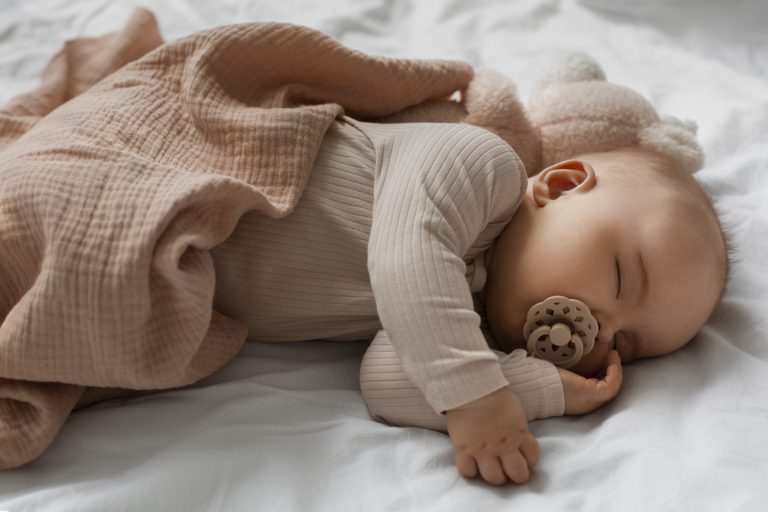Co-Sleeping & Sleep: Finding What Works for Your Family
Co-sleeping—few parenting topics spark as much discussion (and debate) as this one. Some parents swear by it for easier nights, while others worry about long-term sleep habits. As a sleep consultant, I believe that there’s no one-size-fits-all approach—only what works best for your baby and your family. Let’s break down what co-sleeping really means, its pros and cons, and how to navigate sleep while keeping both safety and independent sleep skills in mind.
WHAT YOU CAN EXPECT
What is Co-Sleeping?
Co-sleeping generally refers to parents and babies sleeping in close proximity. This can mean:
- Room-sharing – Baby sleeps in a crib or bassinet in the same room as parents.
- Bed-sharing – Baby sleeps in the same bed as the parents.
While room-sharing is widely recommended for safe sleep, bed-sharing comes with additional safety considerations. If you’re co-sleeping, it’s important to know how to prioritize safety while setting up healthy sleep habits for the future.
The Pros & Cons of Co-Sleeping
Like any sleep arrangement, co-sleeping has its benefits and challenges. Here’s a look at both:
Potential Benefits of Co-Sleeping
- Easier nighttime feedings – No need to fully wake up or get out of bed.
- More sleep for some families – Some babies settle more easily near a parent.
- Stronger bonding – The closeness can feel comforting for both baby and parent.
Challenges & Things to Consider
- Sleep associations – If baby gets used to falling asleep next to you, they may struggle to sleep independently later.
- Parental sleep quality – While some parents sleep better with baby nearby, others sleep more lightly or wake frequently.
- Safety concerns – The AAP recommends room-sharing (not bed-sharing) to reduce the risk of SIDS.
Safety First: Co-Sleeping Considerations
If you choose to co-sleep, safety should be your top priority. Here are some must-follow guidelines:
✨Baby should always sleep on their back – No side or stomach sleeping.
✨ Use a firm, flat sleep surface – Soft beds, pillows, and loose blankets increase risks.
✨ Keep the environment smoke-free – Secondhand smoke is a major SIDS risk factor.
✨ Consider a co-sleeper bassinet – A safe middle ground between independent sleep and closeness.
💡 Pro Tip: If you bed-share, be mindful that transitioning to independent sleep may take extra time and consistency later on.
How Co-Sleeping Affects Sleep Habits
One of the biggest concerns with co-sleeping? Sleep associations.
✨ Babies quickly associate sleep with their environment. If they fall asleep with mom or dad next to them, they may wake up looking for that same comfort throughout the night.
This doesn’t mean co-sleeping is „bad“—but it does mean you may need to actively support independent sleep skills when you’re ready. A consistent bedtime routine and a familiar sleep environment can help.
Parental Sleep & Mental Health Matter Too!
It’s easy to focus entirely on baby’s sleep needs—but your sleep matters just as much. Sleep deprivation can lead to:
- Increased stress and anxiety
- Difficulty regulating emotions
- Struggles with patience and daily tasks
If co-sleeping works for you and you’re feeling rested—great! But if your sleep is suffering, it may be time to reassess your sleep setup or consider gentle sleep training approaches.
Balancing Co-Sleeping & Independent Sleep
Co-sleeping doesn’t mean you have to co-sleep forever. If you love the bonding aspect but want to encourage independent sleep, here are some ideas:
- Start with room-sharing – A bassinet or crib in your room gives baby comfort while promoting safe sleep habits.
- Introduce gentle sleep cues – A dark room, white noise, and a bedtime routine help signal sleep.
- Encourage self-soothing – If baby wakes, try giving them a moment before picking them up.
💡 Thinking about transitioning away from co-sleeping? A slow, step-by-step approach works best!
Final Thoughts: Finding What Works for You
There’s no „right“ way to sleep—only what keeps your family happy and well-rested. Whether you choose co-sleeping, room-sharing, or independent sleep, the key is safety, consistency, and flexibility as your baby grows.
Takeaways from Today’s Discussion:
✨ Co-sleeping can be beneficial but requires extra safety measures.
✨ Setting up healthy sleep habits early makes transitions easier later.
✨ Parental sleep is just as important as baby’s sleep.
✨ A well-rested family = a happier, healthier home.
💤 Need personalized sleep support? Let’s create a sleep plan that works for your unique family! Book a consultation with SleepyStar Sleep Consulting today.


